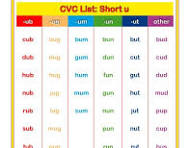Understanding and Teaching Short “U” Words: A Guide for Parents and Educators
Introduction to the Short “U” Sound
The short “U” sound, represented by the symbol (ŭ), is one of the key vowel sounds that children learn when beginning to read. It’s important for young readers to recognize and pronounce this sound correctly, as it forms the foundation for decoding many common words. The short “U” sound is typically heard in words like “sun,” “cup,” and “mud.”
Characteristics of the Short “U” Sound
The short “U” sound is produced by relaxing the tongue and positioning it low in the mouth, with the sides of the tongue gently touching the lower teeth.
This sound is often described as the “uh” sound, as in “cut” or “hug.” Because this vowel sound is common in English, mastering it early on helps children build confidence as they progress to more complex words.
Examples of Short “U” Words
Here are some common examples of short “U” words that children might encounter:
- Jump: The action of propelling oneself off the ground.
- Mug: A large cup used for drinking.
- Sun: The star that provides light and heat to our planet.
- Duck: A waterbird with a broad, flat beak.
- Bus: A large vehicle used for transporting passengers.
- Umbrella: A device used for protection from rain or sun.
- Drum: A percussion instrument that makes sound when struck.
- Truck: A large, heavy motor vehicle for transporting goods.
- Hut: A small, simple, single-story shelter.
- Gum: A chewy substance often flavored, used for freshening breath.
- Cut: To divide something into pieces with a sharp tool.
- Mud: Wet, soft earth or clay.
- Cup: A small, round container used for drinking liquids.
Teaching Tips for the Short “U” Sound
1. Start with Simple CVC Words: Begin by introducing children to simple consonant-vowel-consonant (CVC) words that contain the short “U” sound. Examples include “tug,” “bus,” and “mud.” These words are straightforward and help children identify the short “U” sound in a clear context.
2. Use Word Families: Word families are groups of words that share the same ending sounds, making them easier for children to decode. Common short “U” word families include:
- -ub: cub, tub, club
- -ud: bud, mud, stud
- -ug: bug, rug, jug
- -um: hum, drum, plum
- -un: fun, run, sun
- -up: cup, pup, sup
- -ut: cut, nut, hut
These families can be presented as lists or in fun activities where children match words that sound similar.
3. Incorporate Short “U” in Daily Activities: Use everyday objects and situations to reinforce the short “U” sound. For example, during snack time, point out that “cup” and “mug” have the short “U” sound. When outside, ask your child to find things in the environment that contain the short “U” sound, like the “sun” or a “bus.”
4. Reading Practice with Decodable Texts: Provide children with decodable texts that focus on short “U” words. These are simple stories or passages designed to help young readers practice specific phonics skills. As they read, encourage them to sound out each word and identify the short “U” sound.
5. Games and Activities: Engage children with games that focus on the short “U” sound. For example, you can play a matching game where children pair pictures of objects with their corresponding words. Another fun activity is to have a word hunt, where children search for short “U” words in books or around the classroom.
Conclusion
The short “U” sound is a crucial component of early literacy. By introducing children to a variety of short “U” words, using word families, and incorporating these sounds into everyday activities, parents and educators can help young readers develop strong phonics skills. With practice and encouragement, children will become more confident in their reading abilities and be well-prepared to tackle more complex language concepts.




